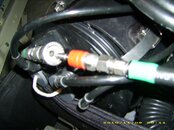Cold, have you talked with the manufacturer about the O2 connection on the head coming loose on you?
The O2 connection on the solenoid is a quick connect very similar to the LPI on a BCD hose. It takes a fair amount of force to push it into the "locked" position. Once locked, it's not coming loose very easily. My guess would be that it didnt fully engage in the locked position and popped loose once the unit was moved. Same thing will happen to your LPI hose if not secured properly. I doubt this was a manufacturer issue.
Here is a pic of the connection. Not the best, but gives you the idea. The O2 supply hose has a needle like connection on it that slips into a collar on the head. The collar is spring loaded and you pull it back, slide the connector in, then release it to lock into place.





